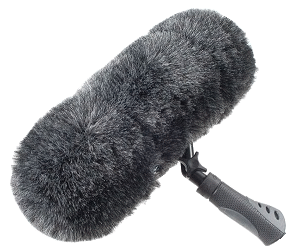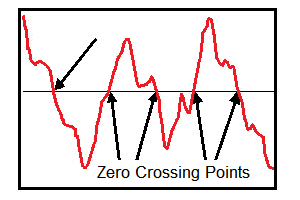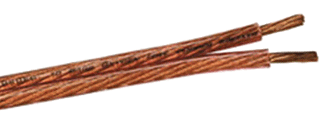——— Z ———

Z – the symbol for impedance.
ZDF – Zero-Delay Feedback filter.
Zener diode – a diode that allows current to flow in the forward direction just like a normal diode, but also permits it to flow in the reverse direction when the voltage exceeds a certain level called the breakdown voltage. It was named after Clarence Zener, who discovered the phenomenon.
zenith – the tilt of the tape head in the direction perpendicular to the direction of recording tape travel.
zeppelin – a slang term for a combination microphone shock mount and windscreen assembly that consists of a skeleton-type shock mount surrounded by foam or other material. It functions as both a shock mount and wind screen and is particularly useful with shotgun microphones which tend to be extra sensitive to handling noise and wind. Its name is due to the fact that it resembles an old dirigible in appearance. Also called a blimp.
zero-based mixing – a technique used in live sound reinforcement that begins with all faders down and then while listening to the stage sound adding only those sources that cannot be heard.

zero crossing – the point where a waveform crosses the point of zero amplitude. This is the ideal location to make an edit since the levels of the two waves are both at zero, which decreases the chances of clicks or pops caused by mis-matched levels.
zero-crossing distortion – see crossover distortion.
zero-delay feedback filter (ZDF) – a type of filter with quick response and minimal artifacts that provides good phase response. They are used in some synthesizers because they provide a more “analog” sound.
zero frame – the first frame on a roll of film or video tape, which is numbered 00:00:00:00.
zero frequency weighting – see Z-weighting.
zero latency – having no delay in processing a signal. See latency and near zero latency.
zero latency monitoring – a technique of routing the input signal directly to the output of the computer in a digital audio workstation in order to minimize latency. Sometimes called low latency monitoring or latency-free monitoring.
zero level – see zero reference.
zero-modulation noise – see tape noise.
zero-order hold (ZOH) – a mathematical model for the practical signal reconstruction performed by a typical digital-to-analog converter (DAC).
zero output – the audio output when no signal is present.
zero-point flanging – a flanging effect using software or hardware to emulate an analog-tape-flanging effect in which the signal from one tape is mixed with the same signal from a second tape that is delayed slightly by pressing on the flange of the tape reel. The pressure on the reel is gradually reduced allowing the second tape to slowly catch up with first until the two tapes are in perfect time alignment (the zero point). The flange on the first tape is then gradually pressed becoming the delayed signal with a slowly increasing delay. This process produces a more dramatic effect than simply flanging one tape reel. Also called through-zero flanging.
zero reference – a standard signal level that is defined as the nominal operating level for a given audio device or a sound system. This level is often set at +4 dBu for professional audio use. Originally, this reference level was 0 VU, then 0 dBm, and later 0 dBu. Also called zero level or zero reference level.
zero reference level – see zero reference.
zero reference point – the lowest point or degree; the starting point or base line for a measurement; the reference point for no signal or null value.
zero ring – a thin ring of plastic placed on a drumhead to control overtones or unwanted resonance. They can be purchased or cut out of old heads. Also called an O-ring.
zip cable – see zip cord.

zip cord – two or more electrical conductors held together by an insulating jacket often used for lamp cord or speaker wire. It is called zip cord because it can be easily separated simply by pulling apart (zipping). Sometimes called zip cable.
zipper noise – an audible noise that occurs in rapid steps as a parameter is changed in a digital audio processor.
ZOH – see zero-order hold.
Zolotarev filter – see elliptic filter.
zone – (1) A defined portion of an audio file in some digital audio workstation. Other DAWs refer to this as a region, event, segment, clip, or sound bite. (2) A section of the keys on a keyboard, controller, or synthesizer that can be assigned different sounds to create a split keyboard.
zone of silence – an area where sound becomes inaudible due to interference or refraction even though it can be heard at distances further from the source. Also called a sound shadow, silent zone, or skip zone.
zoom microphone – a type of microphone with three cardioid microphone elements and a special phase correction equalization circuit. By adjusting a control knob, the microphone output can be varied from omnidirectional through cardioid to supercardioid. These mics are sometimes used in film or video production because the mic perspective can be synchronized with the visual perspective of the zoom lens on a camera.
Z-weighting – a method for measuring sound using a flat frequency response between 10 Hz and 20 kHz ± 1.5 dB (excluding microphone response). Z-weighting was introduced in standard IEC 61672 because sound level meter manufacturers could previously choose their own low and high frequency cut-offs points, which resulted in different readings for each manufacturer. Measurements made with Z-weighting are usually indicated with dB(Z). Also called Zero frequency-weighting. See also A-weighting, B-weighting, C-weighting, D-weighting, and K-weighting.
Zwicker loudness – a scale for expressing the loudness of complex sounds developed by German acoustics scientist Eberhard Zwicker, based on a model that simulates the nonlinear sensitivity of the human ear. Also called Zwicker phons or the Zwicker method.
Zwicker method – see Zwicker loudness.
Zwicker phons – see Zwicker loudness.
Note: We believe this is the largest dictionary (glossary) of terms specific to usage within the recording industry that is currently available on the internet, with more than 8,800 entries, nearly 800 illustrations, and dozens of tables. Some of the terms have different or additional meanings in other situations, especially within the electronic, automotive, scientific, and computer industries. Of necessity there are obvious overlaps into other fields such as music, electronics, and computers, but such excursions are limited to information deemed pertinent to the knowledge required to operate and/or participate effectively in the workings of a recording studio. Also included are terms related to sound reinforcement (live performances) including wireless microphone technology because a working knowledge of that terminology is necessary for recording at live performance venues. Because recording studios also record audio for video and motion pictures (films), some terminology from those fields is included. Some scientific terms are included because they help explain studio terminology. For example, electromagnetism explains how microphones, loudspeakers, and guitar pickups work. Knowledge of radio waves and the radio frequency spectrum is needed to explain wireless devices. Any trademarks or trade names mentioned belong to their respective owners. The information contained in this dictionary is believed to be accurate at the time of publication. This information is subject to change without notice. The information was obtained from and cross-checked with a variety of sources that are believed to be reliable. However, Los Senderos Studio, LLC does not guarantee the accuracy or completeness of the information contained herein. Please contact us to report any errors, omissions, discrepancies, or broken links. Los Senderos Studio shall not be responsible for any consequences or damages arising out of the use of this information. Nothing in this glossary should be interpreted as legal advice. For a glossary providing information on legal and business matters for musicians, we suggest you consult Musicians Business Dictionary.
A note on alphabetical order: The terms in this glossary are alphabetical without regard to spaces and punctuation. For example, AM Radio follows amplitude. While this may seem to be at odds with other conventions, it eliminates confusion with words such as pickup, which is sometimes written as pick up or pick-up. In addition, all symbols such as &, -, or / are ignored. The entries on the number page (0-9) are listed in increasing value within each digit. For example, all of the entries beginning with 1 are listed before those starting with 2. For Greek letters (α-ω), the entries are in Greek alphabetical order.


